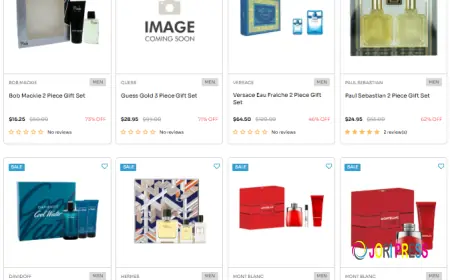Ready to Wear Market to Reach New Heights
The Global Ready to Wear Market is experiencing robust growth, driven by rising fashion consciousness, urbanization, e-commerce expansion, and increasing demand for comfortable, stylish, and affordable apparel across demographics

Introduction
The global fashion and apparel industry has consistently been at the forefront of consumer-driven evolution, and within it, the Ready to Wear (RTW) Market has emerged as a transformative segment. In 2024, the market was valued at USD 153.67 billion and is projected to expand to USD 258.56 billion by 2030, reflecting a CAGR of 9.12% during the forecast period.
Ready to Wear apparel refers to garments manufactured in standardized sizes and sold in a finished form, eliminating the need for tailoring or customization before wearing. The concept, once associated primarily with convenience, has now evolved into a dynamic business model blending affordability, accessibility, and trend-driven innovation.
This market’s growth trajectory is being shaped by rapid urbanization, digital transformation, fast fashion, sustainability initiatives, and shifting consumer demographics. As global populations become more style-conscious, value-driven, and digitally engaged, the RTW industry is entering a new era of opportunity.
Industry Key Highlights
-
Market Size and Growth – The global RTW market is set to expand by more than USD 100 billion in value between 2024 and 2030, showing robust consumer demand.
-
Fast Fashion Dominance – Brands like Zara, H&M, and Uniqlo continue to lead with quick-to-market collections that keep up with evolving fashion trends.
-
Digital Retail Transformation – Online channels are now the fastest-growing distribution networks, driven by e-commerce and social commerce.
-
Sustainability Shift – The global push toward ethical and eco-friendly fashion is influencing product designs, sourcing, and supply chains.
-
Asia Pacific Leadership – With rising disposable incomes, growing youth demographics, and digital penetration, the region is the fastest-growing hub.
-
Consumer Experience Revolution – Technologies such as AR, AI, and virtual try-on solutions are redefining shopping experiences.
-
Changing Demographics – Millennials and Gen Z are becoming key market drivers, with higher demand for affordable, stylish, and sustainable apparel.
-
Competitive Landscape – Both luxury fashion houses and fast fashion giants are competing alongside emerging e-commerce players.
-
Resilient Post-Pandemic Recovery – The RTW market has demonstrated resilience, adapting to remote retailing, supply chain challenges, and renewed consumer confidence.
-
Circular Fashion Momentum – Recycling, resale, and clothing rental models are reshaping consumer buying habits.
Download Free Sample Report - https://www.techsciresearch.com/sample-report.aspx?cid=28432
Market Drivers
1. Rising Demand for Affordable Fashion
Affordability is the single most significant factor propelling the RTW industry. Fast fashion companies have mastered rapid production and distribution, offering stylish designs at competitive prices. By leveraging economies of scale, these brands make seasonal wardrobe refreshes accessible to middle-income groups worldwide.
2. Digital Transformation and E-Commerce Growth
The digital revolution has been a game-changer for RTW apparel. Online shopping platforms not only offer wider product selections but also create personalized shopping journeys with data-driven recommendations. Innovations such as AI-based styling, AR-powered fitting rooms, and virtual fashion shows further enhance consumer experiences.
3. Urbanization and Lifestyle Changes
Global urbanization has fueled demand for RTW apparel. Urban dwellers, often exposed to international trends, prefer convenience-driven fashion solutions. A growing culture of workplace fashion, casual wear, and athleisure has diversified demand within RTW segments.
4. Youth-Centric Consumption Trends
Millennials and Gen Z together account for the largest portion of apparel consumption globally. These cohorts prioritize trendy, expressive, and socially responsible fashion choices. Their reliance on social media platforms for style inspiration makes them key targets for influencer-driven marketing.
5. Globalization of Fashion
Cross-border trade, global media, and digital exposure have created a convergence of fashion tastes. Today, a fashion trend in Europe can rapidly influence consumers in Asia or the Americas, driving synchronized demand across continents.
Emerging Trends in the Ready to Wear Market
1. Sustainable and Ethical Fashion
Sustainability has shifted from being a niche trend to a mainstream expectation. Brands are adopting organic cotton, recycled fabrics, and environmentally friendly dyes, while also focusing on ethical labor practices. The circular fashion model—through rental, resale, and recycling platforms—is expected to significantly shape consumption patterns.
2. Luxury Ready to Wear Evolution
Luxury fashion houses are increasingly investing in RTW lines that combine prestige branding with accessibility. These collections often act as gateway products, attracting younger consumers who aspire to own luxury apparel.
3. Technological Integration in Fashion
Tech-driven fashion is on the rise. Smart fabrics, wearable tech-infused clothing, AI-designed collections, and blockchain for supply chain transparency are reshaping the industry.
4. Influencer and Social Commerce
Influencer-driven fashion has transformed the industry, with platforms like Instagram, TikTok, and YouTube acting as direct-to-consumer retail channels. The role of micro-influencers, who connect authentically with niche audiences, is expanding rapidly.
5. Customization and Personalization
Although RTW traditionally emphasizes standard sizing, modern consumers are demanding personalized fits and designs. Brands are responding with AI-driven size recommendations, customizable embroidery, and limited-edition collections.
Market Segmentation Analysis
By Distribution Channel
-
Online Retail: The fastest-growing channel, fueled by e-commerce giants and direct-to-consumer brand websites.
-
Offline Retail: Still significant, with multi-branded stores, department stores, and brand-exclusive outlets providing experiential shopping.
By Region
-
Asia Pacific: The undisputed growth leader, powered by urbanization, youth demographics, and affordability trends.
-
North America: Mature but lucrative, driven by demand for sustainable and premium RTW lines.
-
Europe: Stronghold of luxury fashion, with sustainability as a critical focus.
-
Middle East & Africa: Emerging due to rising disposable incomes and fashion-forward urban centers.
Competitive Analysis
The global Ready to Wear Market is highly competitive, with both international giants and regional players vying for market share.
Major Companies Include:
-
PVH Corp. – Owner of Calvin Klein and Tommy Hilfiger, excelling in premium RTW apparel.
-
Inditex (Zara) – Pioneer of fast fashion, known for its rapid trend replication and distribution efficiency.
-
H&M Group – Combines affordability with increasing sustainability initiatives.
-
Nike Inc. & Adidas AG – Driving the athleisure and sportswear RTW category.
-
LVMH Moët Hennessy Louis Vuitton SE – Leading luxury RTW through prestige brands.
-
VF Corporation – Owner of Vans, The North Face, and Timberland, with strong outdoor and casual RTW lines.
Competitive Strategies
-
Frequent product launches to keep up with short trend cycles.
-
Investments in digital ecosystems to connect with online shoppers.
-
Collaborations with designers, influencers, and celebrities to drive exclusivity.
-
Sustainability commitments to align with ethical consumer preferences.
Future Outlook
The global Ready to Wear market is on the cusp of a transformational decade. By 2030, the industry will not only be larger in size but also smarter, more sustainable, and consumer-centric.
Key outlook highlights:
-
E-commerce dominance with enhanced AR/VR-enabled experiences.
-
Wider adoption of circular fashion practices, including clothing rental and resale.
-
Sustainability as a competitive differentiator, influencing purchase decisions.
-
Asia Pacific’s emergence as a global fashion powerhouse, surpassing growth in mature markets.
-
Digital-first consumer engagement where data analytics and AI will drive style personalization.
10 Benefits of the Research Report
-
Comprehensive Market Size Analysis – Detailed projections through 2030.
-
Identification of Key Growth Drivers – Insights into evolving consumer preferences.
-
Trend Mapping – In-depth coverage of fast fashion, sustainability, and digital transformation.
-
Segmentation Insights – Breakdown by product type, end-user, and distribution channel.
-
Regional Dynamics – Regional performance analysis highlighting growth hotspots.
-
Competitive Benchmarking – Analysis of leading brands and their strategies.
-
Future Growth Opportunities – Identification of emerging opportunities and untapped markets.
-
Risk & Challenge Assessment – Examination of supply chain risks, competition, and sustainability pressures.
-
Consumer Behavior Analysis – Understanding shifts in demographics and spending patterns.
-
Decision-Making Support – Actionable intelligence for investors, retailers, and manufacturers.
Conclusion
The Ready to Wear Market represents more than just clothing—it embodies the intersection of convenience, culture, technology, and sustainability. With its projected expansion to nearly USD 260 billion by 2030, this industry is set to redefine global fashion consumption.
The next phase of growth will depend on the industry’s ability to balance affordability with responsibility, speed with quality, and trend responsiveness with sustainability. As digital commerce, eco-consciousness, and cultural diversity reshape consumer preferences, the RTW market will continue to evolve as one of the most influential sectors in the global economy.
Contact Us-
TechSci Research LLC
420 Lexington Avenue, Suite 300,
New York, United States- 10170
M: +13322586602
Website: www.techsciresearch.com
What's Your Reaction?
 Like
0
Like
0
 Dislike
0
Dislike
0
 Love
0
Love
0
 Funny
0
Funny
0
 Angry
0
Angry
0
 Sad
0
Sad
0
 Wow
0
Wow
0


















































